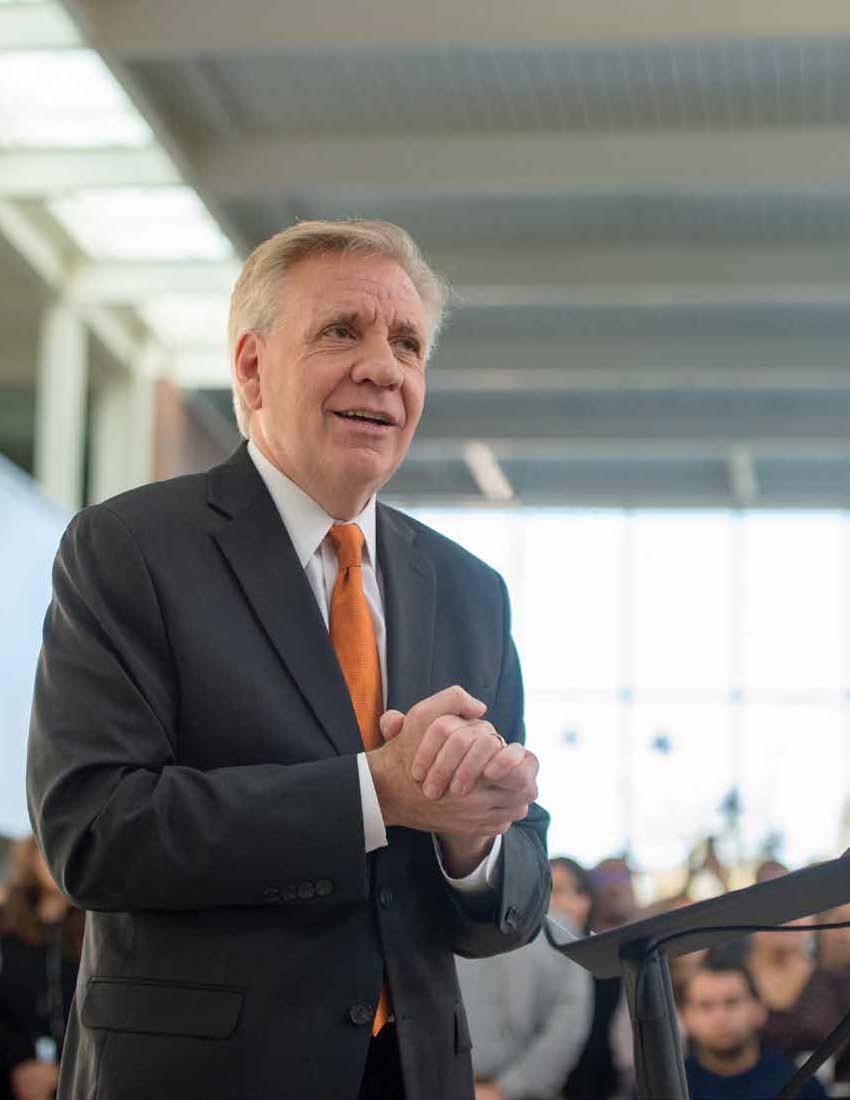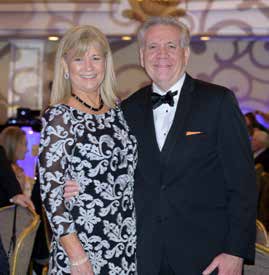By Jennifer Langham
In November, the Board of Regents announced that Christopher Callahan will be the next president of University of the Pacific—the 26th person to hold the position in the history of the University. Over the last few months, Callahan has been preparing for the job with a series of visits to all three campuses.
As president designate for University of Pacific, Christopher Callahan is doing more than simply introducing himself to students, faculty and staff prior to his July 1 start date. Callahan is making it his mission to learn and to tell the stories about how Pacific offers something unique in undergraduate and graduate education.
Callahan’s own higher education story begins as the first person in his family to attend and graduate from college, an achievement for which he credits his hard-working parents. “It was made crystal clear to me that the path for success in life would be through higher education,” said Callahan. “My parents did many things through my K-12 schooling that would prepare me for that experience, but mostly they provided a culture in our house where going to college was expected.”
He loved sports as a child—baseball remains a passion—but in high school he discovered journalism. A beloved math teacher died, and Callahan wrote an article about her for the school newspaper. “I found it very empowering, this notion of sharing stories with others, and despite the sad topic matter, I was really excited by that,” he says.
Callahan decided to attend Boston University (BU) because it had a strong journalism program and wasn’t too far from his home on Long Island, New York. He earned a bachelor of science degree in journalism from BU’s College of Communication and worked as a journalist for the Associated Press before returning to school for a master of public administration from Harvard University’s John F. Kennedy School of Government. An adjunct teaching opportunity back at Boston University sparked an interest in journalism education. Callahan says, “It was really rewarding to be on the other side of the higher education equation, to help young people with similar interests with their career goals.”
He went on to serve in faculty and leadership roles at the University of Maryland’s Philip Merrill College of Journalism, one of the early experiential learning environments in journalism education. In 2005, Callahan became the first dean of the Walter Cronkite School of Journalism and Mass Communication at Arizona State University (ASU). Currently, he also serves as vice provost of ASU’s downtown Phoenix campus and CEO of Arizona Public Broadcasting Service (PBS).
Callahan is making it his mission to learn and to tell the stories about how Pacific offers something unique in undergraduate and graduate education.
In his 30 years of working in higher education, he notes, he has never been at an institution with a dental school. “So I’ve been doing a deep dive to get to know the Dugoni School,” Callahan says. And this meant learning about the Arthur A. Dugoni School of Dentistry story from the source: Art Dugoni himself.
Callahan describes sitting down with Dr. Dugoni in December: “I had read about all the wonderful things he has done for the school and for the discipline of dentistry, and I expected to meet an elder statesman. But what I found was someone who seemed to have more energy than I did when I was 30. We had a wonderful conversation and he told me about his philosophy on leadership. It was really a privilege to have that interaction, and then to also see how Dean Nader Nadershahi was just the perfect person to continue Art’s work.”
Touring the dental school, meeting the dedicated faculty and staff and seeing the state-of-the-art facilities on the campus in the heart of San Francisco was impressive, Callahan said. But meeting with students at the Dugoni School illustrated what makes the school special. “It was just before finals, and I expected these young people to be pulling their hair out, but they were incredibly welcoming,” he said. “The students are gregarious, passionate and positive, and they are unbelievably supportive of each other. It was so moving to see.”
“I’ve been doing a deep dive to get to know the Dugoni School,” Callahan says. And this meant learning about the Arthur A. Dugoni School of Dentistry story from the source: Art Dugoni himself.
The Dugoni School of Dentistry’s story is an easy one to tell, Callahan reflects, “because it’s a story about one of the very best schools of dentistry in the entire country by every measure, and at the same time it’s a place with this humanistic approach where you walk in the door and you feel like you’re part of the family.”
Creating a narrative about leadership, resources and students is a skill Callahan honed at the Cronkite School, where he increased student enrollment, more than tripled the size of the faculty, created new programs and research partnerships and raised more than $100 million. It was an experience that enhanced his sensibility for innovation and entrepreneurship, skills that are necessary for navigating today’s higher education landscape, he says.
“We don’t have the luxury anymore, in higher education, of moving at a slow, methodical pace,” Callahan says. “But what I found at ASU is that it’s empowering to move faster, to move collaboratively. And frankly, it’s much more fun when you’re accomplishing things, when you’re providing new, exciting experiences for students and you see them growing from those.”
What are Callahan’s ideas for innovating at Pacific? He says that Pacific’s three campuses provide a unique characteristic that can be capitalized upon in new ways. “Today you see some interconnectivity between the campuses, but I could envision a future where, instead of students taking a semester abroad, you might have a Conservatory of Music student from the Stockton campus who spends a semester working with artists in San Francisco, or a student who wants to go into government spending a semester in Sacramento with a law firm or nonprofit.”
He points to what he sees as some of the special characteristics across the three Pacific campuses: small classes with master teachers, innovative joint-degree programs, experiential learning opportunities and nine different colleges on three different campuses in three distinct cities.
“We have the base of really extraordinary, innovative programs for our students, but I think there’s a lot more to do, and it comes back to that notion of distinctiveness. What makes Pacific distinctive? Certainly the three campuses do that in a way that other universities simply don’t have.”
Callahan’s visits to Pacific’s campuses have all included his wife of 33 years, Jean, whom he describes as a “full partner” in the move to this next chapter of their lives. Jean is a human resources executive whose job enables her to work remotely, but she also plans to be highly involved with the University. On a recent visit the couple made to Pacific, Jean met with student body presidents to get ideas about how she could help student leaders on the different campuses.
The younger of the Callahans’ sons, Casey, is still a student himself, completing his degree at ASU where he’s studying computer gaming design. Their older son, Cody, who also graduated from ASU, is a staffer doing baseball analytics for Major League Baseball’s Arizona Diamondbacks. “It’s a good time in the family for this career opportunity,” Callahan says.
And as the next president of the first chartered university in California prepares to begin his tenure, it’s a great time for Pacific to differentiate its own story.
“I think the ability to tell our story is absolutely critical to Pacific’s future success,” Callahan says. “As higher education becomes more and more competitive, we need to be able to articulate our story in powerful ways across all sorts of different platforms to prospective students, and to our own community supporters and leaders and throughout higher education.”
Callahan reflects that the disparate experiences in his own life story—his experience as a first-generation college student, his work as a journalist and his work in higher education—have the common thread of a natural curiosity for gathering information and sharing information.
And as the next president of the first chartered university in California prepares to begin his tenure, it’s a great time for Pacific to differentiate its own story.
As he learns more about Pacific’s three campuses, about their histories and resources, this curiosity, Callahan says, will help him articulate why a student would want to come to Pacific, why a donor would want to give to Pacific and why a corporation would want to partner with Pacific.
“Pacific has a powerful story, and telling that is one of my challenges.”
Jennifer Langham is a contributor to Contact Point and other University of the Pacific publications.





